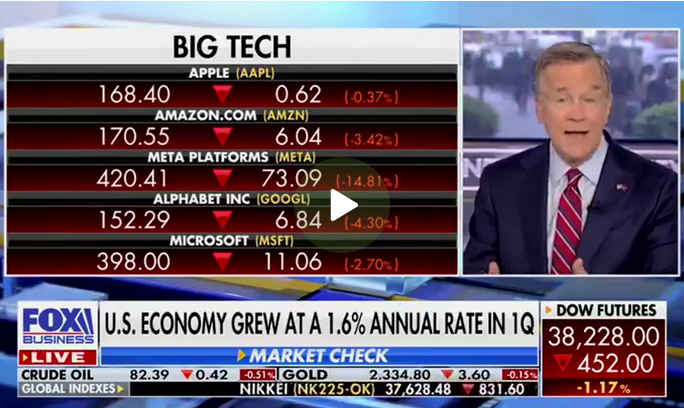President Joe Biden’s reelection campaign was met with unsettling economic news today as recent GDP figures fell short of expectations, exacerbating concerns of a looming stagflation scenario reminiscent of the 1970s.
The anticipated GDP growth of 2.4% sharply contrasted with a sobering actual increase of just 1.6%. The lower-than-expected growth figures come at a time when inflation continues to rise, challenging the administration’s efforts to stabilize the economy.
Experts on Fox News Business pointed to the dual threat of sluggish growth coupled with persistent inflation, noting the Federal Reserve’s admission that inflation is not only “sticky” but also trending adversely. Economic analysts are raising the alarm over the potential for stagflation, a condition characterized by slow economic growth, high unemployment, and rising prices. Such an environment could pose significant challenges to Biden’s campaign for 2024, as voters often base their ballots on economic performance.
“I was preparing myself for using the word ‘stagflation’ because that’s something we haven’t seen since the 1970s,” Fox News Business commentator David Asman remarked during the segment discussing the economic data. This historical parallel draws comparisons to the economic difficulties that plagued the Carter administration.
WATCH:
The U.S. economy grew at a slower pace in the first quarter of 2024, with real gross domestic product (GDP) expanding at an annual rate of 1.6%, according to preliminary data from the Bureau of Economic Analysis. This marked a significant deceleration from the 3.4% growth recorded in the fourth quarter of 2023.
Key components contributing to GDP growth included increased consumer spending, higher residential and nonresidential fixed investment, and more state and local government spending. However, these gains were somewhat tempered by a decrease in private inventory investment and an uptick in imports, which subtracted from total GDP calculations.
Consumer expenditure rose notably in services such as healthcare and financial services, although spending on goods like motor vehicles and energy products saw declines. Overall current-dollar GDP increased to $28.28 trillion, up $327.5 billion from the previous quarter. The GDP price index and personal consumption expenditures (PCE) price index both rose, indicating heightened inflationary pressures with the PCE price index, excluding food and energy, climbing to 3.7%.
Personal income also saw a substantial rise, driven largely by higher compensation and government transfer receipts, leading to an increase in disposable income despite higher personal taxes. However, the personal saving rate dipped slightly compared to the previous quarter.
This “advance” GDP estimate is preliminary and will be revised in a more comprehensive report due on May 30, 2024, which will incorporate more complete data.
The report indicates the economy is slowing, while inflation remains persistent. This has altered expectations for when the Federal Reserve might cut interest rates. Recently, Federal Reserve officials have stated that controlling inflation might necessitate maintaining interest rates at their highest levels in two decades for an extended period.
As the campaign trail heats up, Biden’s team is likely to recalibrate their economic message in hopes of reassuring an increasingly anxious electorate. Economists warn that if trends continue, the U.S. could face a prolonged period of economic difficulty that might require significant policy overhauls to prevent long-term damage.

Leave a Reply